Disaster Risk Management and the COVID-19 Response in Afghanistan by Aga Khan Agency for Habitat Afghanistan
Executive Summary
Founded in 2015, Aga Khan Agency for Habitat (AKAH) works to support the creation of safe sustainable habitats in which communities, families and individuals can thrive. In line with the ethos of the Aga Khan Development Network (AKDN), special emphasis is placed on building self-reliance and resilience, expanding opportunity, and improving quality of life for people of all faiths, backgrounds and origins.
Aga Khan Agency for Habitat Afghanistan (AKAH, A) operates in 7 provinces in the country and has already reached more than 730 villages. As the agency is collecting a large amount of information related to hazard data in a wide geographic range, it becomes crucial to be able to have access to real-time data so as to make timely and informed decisions.
AKAH,A started using ActivityInfo in 2019 with the aim to replace the former paper-based data collection system. Today, 80% of the data collection handled by the agency is managed via ActivityInfo.
Following the fast developments related to COVID-19, AKAH,A presented ActivityInfo to the Ministry of Public Health of Afghanistan (MoPH) as a solution and the teams jointly worked on streamlining data management related to COVID-19 data in the 34 provinces of the country. In March 2020, the MoPH and AKAH, A started collaborating and in May 2020 their synergy resulted in the creation of a system that linked 34 provinces of Afghanistan with the Crisis Coordination Center in Kabul. The system is used to manage data related to the COVID-19 response, in ActivityInfo.
We spoke with Mr. Shodmon Hojibekov, Chief Executive Officer in Aga Khan Agency for Habitat Afghanistan and Mr.Iqbal Sufizada who is leading the Monitoring, Evaluation, Research, Learning and Innovation department in AKAH,A who explained to us the way ActivityInfo is used within the agency for managing data related to AKAH,A activities as well as how the synergy between the agency and the MoPH led to a complete data collection system for COVID-19 residing in ActivityInfo.
Aga Khan Agency for Habitat in Afghanistan
Aga Khan Agency for Habitat (AKAH) is part of the social development branch of a larger network, the Aga Khan Development Network (AKDN). AKDN’s work covers a continuum of development activities including agriculture and food security, economic development, civil society, culture, education, financial inclusion, health, humanitarian assistance, and industrial and infrastructure development through an integrated area development approach.
With the head office in Geneva and field offices in Tajikistan, Afghanistan, Pakistan, India and recently in Syria, Aga Khan Agency for Habitat works on 4 key pillars revolving around safety, resilience, services and opportunities in regions and populations that are affected by climate change, natural risk hazards and other complex emergencies.
Aga Khan Agency for Habitat, previously named Focus Humanitarian Assistance, started its work in Afghanistan in 1996. Today, the agency strives to make sure that people living in high risk areas are able to live a safe life and to cope with the impacts of climate change and various natural hazards, such as avalanches, rock falls, flooding and other by increasing the resilience of the communities in these areas.
With the cooperation of experts and local communities the teams of the agency have been building the risk profiles of hundreds of villages in 7 provinces in the country with the aim to prevent or mitigate the impact of potential hazards and to increase the capacity of people to help each other. They work on a variety of activities including disaster preparedness trainings, vulnerability assessments, risk mitigation, community drills, emergency stockpiling, climate change adaptation, and many more.
The agency also works towards creating an enabling environment for these communities so that people are able to get the required social and financial services that can lead to more opportunities to achieve better quality in their lives. Activities related to this mandate include water supply, sanitation and hygiene, education and health infrastructure, energy efficiency, greenhouse gas reduction and many more.
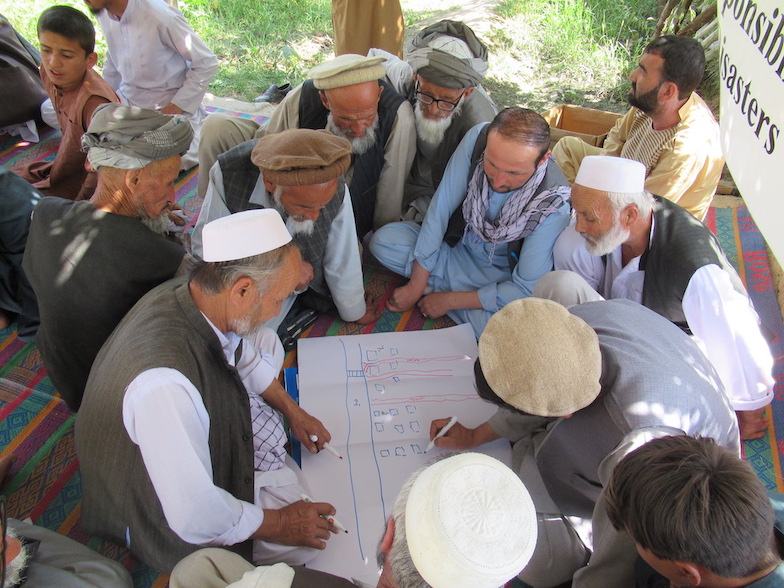
AKAH,A works with other agencies of the Aga Khan Development Network and with other external partners such as the UN agencies and line ministries such as the Ministry of Mining and Petroleum, the Ministry of Transport, the National Environmental Protection Agency, the Weather Monitoring Organization, the Ministry of Water, the State Ministry for Disaster Management and Humanitarian Affairs, the Ministry of Urban Development and the Ministry of Public Health in Afghanistan and provides services and expertise in various areas.
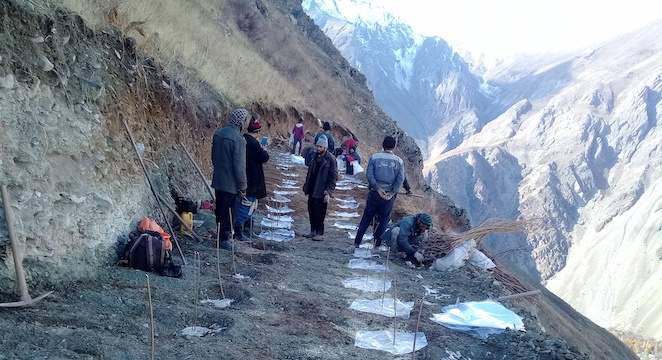
ActivityInfo for Disaster Risk Management Response and Monitoring and Evaluation
With more than 300 staff working in 7 out of the 34 provinces of the country, AKAH,A runs a wide range of activities supporting their mandate and has already covered more than 730 villages across these geographic areas. The agency started using ActivityInfo in the beginning of 2019. Today, the agency manages and collects in the platform a considerable amount of data related to these activities, reaching around 80% of the total data collected.
The decision to use ActivityInfo came as a result of a very thorough reflection on how to create a solution to optimize and meet the expectations that the agency had for data management. Before ActivityInfo, the data collection processes were mostly paper-based and collecting data would take too much time. People would need to go to the field, collect data, come back, enter the data, clean and process it.
This was a crucial process affecting a large amount of information related to hazard data because of the wide geographic coverage of the agency.
The shift from paper-based data collection to using ActivityInfo was characterized as a paradigm shift within the agency by Mr. Hojibekov, Chief Executive Officer in AKAH,A.
“This change is actually a very significant shift. I would call it a paradigm shift between the way we were working before and how we are working right now”, states Mr. Hojibekov.
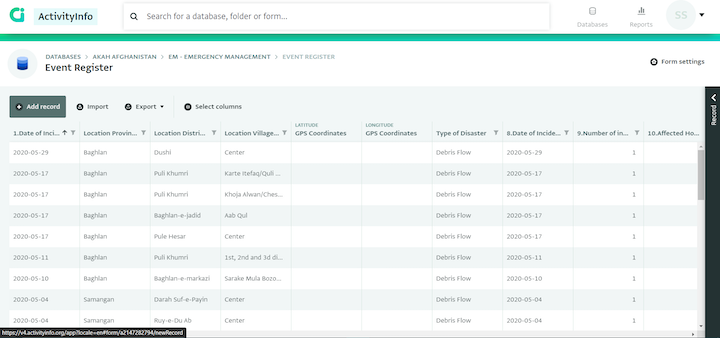
The reasons why the AKAH,A decided to start using ActivityInfo were intrinsic to the way data collection was done within the agency up to that time.
In the past, there were challenges related to data accuracy mainly due to significantly wide geographic coverage and reach of their programmes. Also, there were issues with hard copies of data.
Mr. Sufizada, who is leading the MERLI department in Aga Khan Agency for Habitat, explains,
“We had challenges in the data collection part. We had issues with data accuracy as geographically we are very expanded.
We do our regular programming for 7 core provinces but then we also do the response for many other provinces as well. We had some serious issues when we were receiving the data from the field and with the hard copies.
So we thought that the best is to have a system to enable us to be very simple and to do quality data collection.”
As Mr. Hojibekov was already acquainted with ActivityInfo from his previous working position, he introduced the software as a solution to the agency.
“Everybody here saw the value of ActivityInfo and how it serves as an amazing data warehouse and an integrated data management function that links all strategic partners to one platform”, explains Mr. Hojibekov.
At present, apart from being the centralized place for collecting and analyzing this type of information, ActivityInfo saves time when dealing with hazard vulnerability risk assessment data which is crucial as geologists, social mobilizers and engineers across all the provinces can provide real-time data to the data processing units within the management department to enable quick decision-making.
According to the agency, ActivityInfo brings in a lot of positive results to the programming too. Teams are able to set up their systems and to capture data coming in from a variety of sources giving a new level of business intelligence to the agency.
“If we speak in terms of effectiveness I think we are noticing tremendous effectiveness in our programming. Previously, we had too much canned data and too much paperwork. Now we see we are getting a lot of data on the platform and early teams are setting up very good data engineering systems.
It is just the second year of using ActivityInfo and a lot of effort has been put from all of us. Various types of data come in the channel and we also capture data coming from secondary sources. Then by fusing this and pivoting it, we get a very different level of business intelligence“, states Mr. Hojibekov.
In Aga Khan Agency for Habitat, there is a department that focuses on working with all the types of data that come to the agency and also provides support to other departments and agencies so they can have a synchronized information management system. This is the Monitoring, Evaluation, Research, Learning and Innovation (MERLI) department and the work of this department is crucial for decision making across the agency.
Under the agency’s mandate for safe and resilient communities, AKAH,A works closely with experts such as geologists, engineers and social mobilizers to calculate the risk profiles of various areas and to then do community-based disaster risk management in close cooperation with community members.
Using GIS technology, satellite imagery, and participatory rural appraisal tools they look at the history of the villages and how they have been impacted through time.
In the end, the combination of both the scientific knowledge and the local wisdom brings out the village Disaster Risk Management Plan.
This plan covers the hazards profiles, the village profile, the risks and it goes over emergency response, first aid incident command systems, community volunteers and many more activities.
The data collection processes related to this data and to the Disaster Risk Management Plan are done via ActivityInfo. The agency collects both high level and low level data such as detailed information at the community level using different Forms to collect various types of needed information.
ActivityInfo is also used to collect data for the emergency responses and the national standard Forms which are used to collect damages and losses related to disasters.
In addition, ActivityInfo is used in the Monitoring and Evaluation work done by the M&E teams of the agency. The Monitoring and Evaluation department is currently finalizing the monitoring templates for field monitoring reports so that the teams working in the field can provide real-time reports from the fields including textual, numerical and pictorial data.
As for the way they structure their Databases and Forms in ActivityInfo Mr. Sufizada, Head of the MERLI department in the AKAH,A states that it really depends on the activities and the programmes. There are times when Forms are used in combination with Subforms but this is limited.
The general conclusion the MERLI department reached after working for some time with many Forms is that the Form needs to be simple even if the data that needs to be collected is of a more complicated nature.
The general conclusion the MERLI department reached after working for some time with many Forms is that the Form needs to be simple even if the data that needs to be collected is of a more complicated nature.
In most cases, they use a single Form and divide it in many sections using relevance rules based on the type of information they collect. This way they guide the users and helpt them reach the part of the Form that needs to be answered, depending on the answer that they give. Parts of the Form remain hidden if there is no need for an answer.
“It is different with every activity and programming. There are areas where we use Subforms but this is very limited. The main thing and a very good learning is that the Form should be simple.
However we make it, it should not be very complicated. In most cases we use a single Form to do the data collection and we divide the Form based on the type of information. So suppose there’s a question that has ‘yes’ or ‘no’ as an answer After replying ‘yes’, there are more questions but if the reply is ‘no’, you move to another part of the Form. That is the way that we are using the Forms. But there are also other activities that use Subforms as well”, explains Mr. Sufizada.
The agency works with various partners and aims to expand their partnerships further. In ActivityInfo, the partner organizations work on the data collection so the AKAH,A provides them with the proper permissions to be able to do data collection.
The agency is also introducing ActivityInfo to sister agencies and other external partners and is exploring other ways so as to further capitalize on its use.
“Our teams are using ActivityInfo to communicate the data; the simple and very minimalist interface that it has makes our business very pleasant. People who use the templates we create, provide very positive feedback on the use“, adds Mr. Hojibekov.
Based on the data collected the AKAH,A works also on the data analysis part and on visualizations. After the data is collected in ActivityInfo the agency analyzes the data and creates visualizations using the ActivityInfo API and visualization software.
Comparing ActivityInfo with setting up internal systems or other IT solutions, Mr. Hojibekov notes that sometimes these solutions prove to be too dependent on external technical help or on help from the people who built them. The regular maintenance and upgrading of such systems is a cost which most of the time is unbearable even for a whole country.
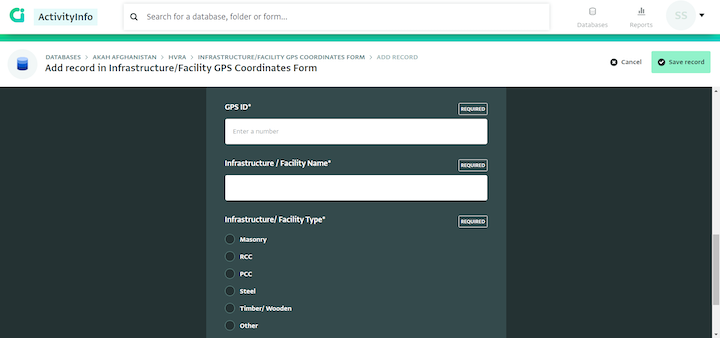
Also, sometimes people, who build and set up these systems, leave the organization and then the systems are abandoned too. Mr. Hojibekov explains:
“There is criticism on setting up systems and IT solutions which are too dependent on external help and too expensive and their regular maintenance, upgrading and cost is too unbearable for countries such as Afghanistan. But when it comes to ActivityInfo, in the discussions that we have, there is always applause and there is always a very positive reflection on how efficient ActivityInfo is in data management and particularly in data collection functions for various businesses.“
At the same time, the technical team of ActivityInfo remains available to support the agency in any questions or clarifications regarding the platform. Having support from a team behind a solution when there are questions is also important and welcomed by the agency.
“The service and support that we receive from the technical team and overall all the teams of ActivityInfo is a great thing for us. Especially, the technical team always provides very timely support on using ActivityInfo, whenever we have any need in a very effective way so that we solve the issues or challenges we might have or we get answers to our questions”, states Iqbal Sufizada, Head of the MERLI department in Aga Khan Agency for Habitat.
In addition to the agency’s activities which are related to risk management, ActivityInfo has been introduced by the agency to one of their partners, the Ministry of Public Health of Afghanistan (MOPH).
Following a collaboration between the two sides on Form design, ActivityInfo is currently used to track the COVID-19 response in the whole country.
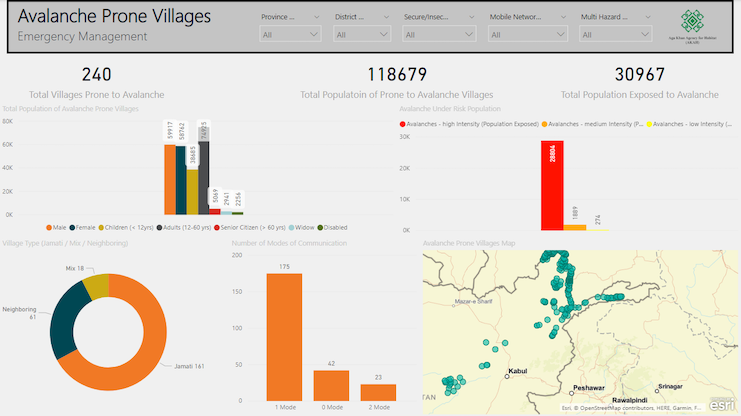
ActivityInfo for the country-wide COVID-19 Monitoring Response
In May 2020, in a meeting between the MoPH and the AKDN agencies in Afghanistan, the MoPH requested AKAH, A to cooperate with the Crisis Coordination Center for the COVID-19 response in the country.
Data management was one of the key priorities identified for a more effective and efficient response in managing the COVID-19 response in the country.
Using ActivityInfo to monitor activities and developments related to COVID-19 across the 34 provinces of the country was agreed because of AKAH,A’s intensive experience of using ActivityInfo in its Emergency Operation Centers.
More specifically, ActivityInfo was suggested by AKAH,A to the MoPH in Afghanistan as a solution to the need for a streamlined process for data management and a simple and easy data management tool to collect and manage all the information related to COVID-19.
At first, data related to the developments of the pandemic were arriving to the Ministry of Public Health from a variety of sources, including phone calls, emails and messaging applications, from all the provinces in the country. Every province has a Crisis Coordination Centre (CCC) providing updates.
Therefore, there was the need to coordinate this significant amount of data in order to provide meaningful daily reports on the situation to the government, the media and the people of the country.
At the same time, AKAH,A had established 6 Emergency Operation centres in the country, tailored to the needs of the response to COVID-19.
These Emergency Operation centres teamed up with the Crisis Coordination centres and through this synergy the 34 provinces were connected to Kabul in a consistent way.
At the first steps of the synergy there was a planning phase during which the two partners collaborated to define the requirements for the different types of data and Forms.
Then the Forms were designed, modified and optimized based on new lessons learnt during the process.
During the design process both partners wanted to make sure that people filling in a Form wouldn’t need to go to various parts of the platform or view parts of the Form that were not needed.
Once the system was in place and challenges of internet connectivity were addressed, both partners provided the orientation, the training and user guidelines in local languages so that people in the provinces could quickly start using the platform to report on their data. Since then all formal data related to COVID-19 are collected in ActivityInfo using Forms in one Database under the Ministry of Public Health.
People reporting just have to open the Form and fill in the data and this is manageable by them. The Ministry can quickly access the data and the developments in the country through a single source. Some people from AKAH,A are also part of this Database to help by monitoring the process and control issues that may arise regarding the data.
“People find ActivityInfo much easier compared to many other tools that were developed before and during COVID-19.
There were some online data collection tools that were not able to make people use them because of their complication.
Due to the low capacity in the provinces people are not very familiar with the technology, the online systems, etc.
But with ActivityInfo they are very happy because it is very simple and easy to connect. Another good thing is that it doesn’t require a very strong bandwidth or to be connected to the internet.
And now all the data is being collected through ActivityInfo and the Ministry of Public Health is using it for their reporting, based on the system that we developed,” notes Iqbal Sufizada, Head of the MERLI department in AKAH,A.
As for the quick reaction of the ActivityInfo team to assist the Ministry of Public Health and AKAH,A in the monitoring of the COVID-19 response in the country, Mr. Hojibekov concludes,
“The level of humanitarian sympathy that has been shown by ActivityInfo, showed that ActivityInfo is not like many other software developing companies aimed at profit only, but in cases of emergency, it really sympathizes and really helps agencies like Aga Khan Agency for Habitat Afghanistan within providing the required emergency support.”
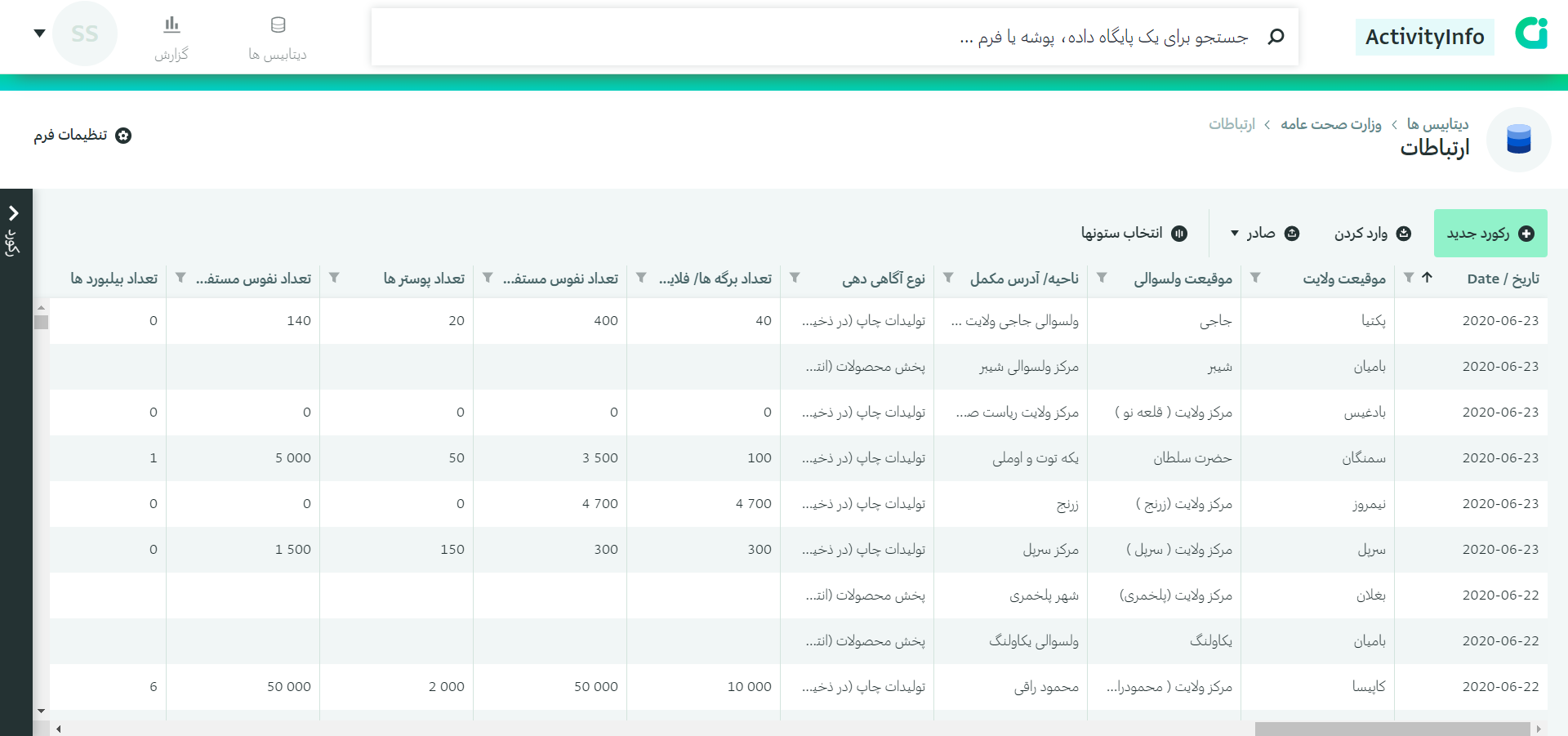
Conclusion
All in all, Aga Khan Agency for Habitat (AKAH) in the Islamic Republic of Afghanistan started working with ActivityInfo when they decided that a significant change in data management would facilitate the way they handle data coming in from various sources throughout the 7 provinces of the country where they are active.
Soon, various Forms were designed in ActivityInfo and the agency started collecting data from experts and local communities in the field as well as from partner organizations using the system.
Following the unprecedented developments of COVID-19, Aga Khan Agency for Habitat Afghanistan collaborated with the Ministry of Public Health of Afghanistan to set up a system for collecting and managing data related to the COVID-19 response, using ActivityInfo. This synergy brought quick results and assisted the Ministry of Public Health in coordinating and managing a large amount of data coming in from the 34 provinces of the country, in various formats.

For Aga Khan Agency for Habitat Afghanistan the shift to ActivityInfo from a paper-based data collection system was a paradigm shift which today allows the teams within the agency to communicate quickly and efficiently based on real-time data.
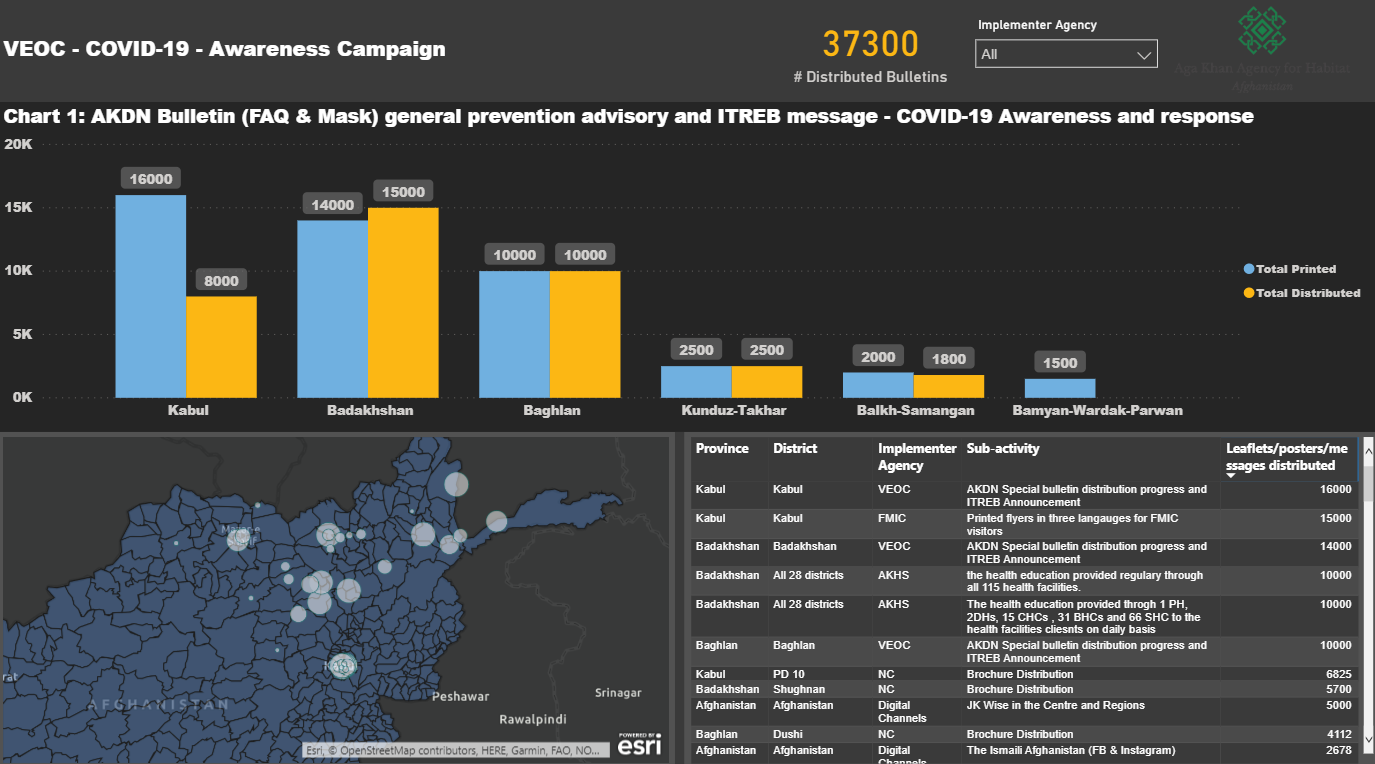
This also enables faster decision making based on a new level of business intelligence. Thanks to the simplicity of the platform, the teams using it are self-dependent and do not need to wait for external help. At the same time, having the support of the ActivityInfo team at any given time for any potential questions helps the agency move forward quickly.
Self-dependence was an important factor for the agency when considering potential solutions. With ActivityInfo, there is no need for external consultants to configure the Databases or apply time-consuming changes to Forms and Databases as these can be done directly by the users.
“There is always an emphasis on self-dependence and not making organizational systems dependent on outside help. There were so many good systems developed in the past but when the people who developed them left, the systems were abandoned too.
But what we note with ActivityInfo is that it really doesn’t matter if there is any help from outside or not.
At the organizational level, they make use of the system because of its simplicity, its effectiveness and minimalistic interface - but very good functionality - and other local experts are managing the system very well too which is I think very important for the sustainability of the system“, concludes Mr. Hojibekov.
We would like to warmly thank Mr. Shodmon Hojibekov, Chief Executive Officer in the Aga Khan Agency for Habitat, Mr.Iqbal Sufizada, leading the MERLI department in the Aga Khan Agency for Habitat and Mrs. Trushna Torche from the Head Office team in AKAH,A for providing valuable insights for the creation of this Case Study.